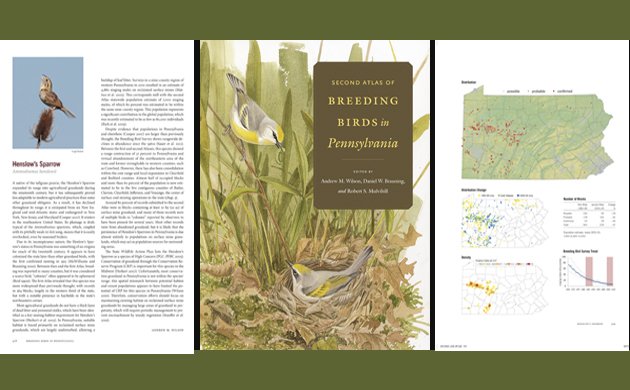
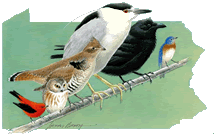 A breeding bird atlas is a special kind of book. For birders, it’s the extremely large book, shelved in a place where it can’t crush the field guides, used to research the history of a bird in their area. Corey did just this in this 2011 posting about Vesper Sparrow Pooecetes gramineus in New York State. For ornithologists, it is the documentation of a multi-year project designed to record the distribution and abundance of birds in a specific area (in North America, usually a state or a province), utilizing a mapping method involving blocks and grids. For conservationists and policy makers, birding atlases provide hard scientific evidence about changes in avian populations, which can in turn be analyzed as evidence of significant changes in biodiversity and our ecology. For the nature lovers and birders who participate in breeding bird surveys, the atlas represents hours, often hundreds of hours, of volunteer time spent within a community of citizen scientists doing what they love, observing birds. So, when Corey and Mike asked if I wanted to review the Second Atlas of Breeding Birds in Pennsylvania, I jumped at the chance to write about this unique type of scientific reference book. I was also curious, as a birder of the northeast United States, to see what kind of avian changes have been going on in Pennsylvania. It is a state I have occasionally birded and should bird more often; a rectangular land mass that encompasses diverse habitats and which tantalizingly bridges the familiar Northeast with the mysterious Midwest. The Second Atlas’s logo, designed by bird carver Larry Barth, with its perched Scarlet Tanager, Northern Saw-whet Owl, Ruffed Grouse, Black-crowned Night-Heron, Common Raven, and Eastern Bluebird, gives a good idea of the diversity of birds that can be found in Pennsylvania.
A breeding bird atlas is a special kind of book. For birders, it’s the extremely large book, shelved in a place where it can’t crush the field guides, used to research the history of a bird in their area. Corey did just this in this 2011 posting about Vesper Sparrow Pooecetes gramineus in New York State. For ornithologists, it is the documentation of a multi-year project designed to record the distribution and abundance of birds in a specific area (in North America, usually a state or a province), utilizing a mapping method involving blocks and grids. For conservationists and policy makers, birding atlases provide hard scientific evidence about changes in avian populations, which can in turn be analyzed as evidence of significant changes in biodiversity and our ecology. For the nature lovers and birders who participate in breeding bird surveys, the atlas represents hours, often hundreds of hours, of volunteer time spent within a community of citizen scientists doing what they love, observing birds. So, when Corey and Mike asked if I wanted to review the Second Atlas of Breeding Birds in Pennsylvania, I jumped at the chance to write about this unique type of scientific reference book. I was also curious, as a birder of the northeast United States, to see what kind of avian changes have been going on in Pennsylvania. It is a state I have occasionally birded and should bird more often; a rectangular land mass that encompasses diverse habitats and which tantalizingly bridges the familiar Northeast with the mysterious Midwest. The Second Atlas’s logo, designed by bird carver Larry Barth, with its perched Scarlet Tanager, Northern Saw-whet Owl, Ruffed Grouse, Black-crowned Night-Heron, Common Raven, and Eastern Bluebird, gives a good idea of the diversity of birds that can be found in Pennsylvania.
Data collection for the Second Breeding Bird Atlas Project of Pennsylvania took place from 2004 through 2009, roughly twenty years after the first official atlas project, 1983 through 1989. It involved 83 regional coordinators directing over 2,000 volunteers, who made more than 77,500 visits to 4,937 Atlas blocks across the state. It included surveys of nocturnal and marsh birds, and a point count survey of songbirds. The project planning team worked with the Cornell Laboratory of Ornithology to develop a new type of Internet data atlassing application, based on eBird. They utilized GIS (geographic information systems) technology to pinpoint breeding bird location to a level far beyond the usual block-based geographic model. It was a gigantic, innovative project that collected and catalogued massive amounts of data about birds, habitat, and ecological change. The resulting book, 616 pages in length, 6.4 pounds in the hand, relates how the project was conceptualized and carried out, and exactly what was learned about the 190 breeding birds of Pennsylvania.
So, what exactly does a breeding bird atlas contain? The Second Atlas of Breeding Birds in Pennsylvania (hereafter known at the Atlas) is organized into nine chapters and seven appendices, with a 38-page bibliography of Literature Cited and a comprehensive Index. The Foreword, by writer and Pennsylvania birder Scott Weidensaul, nicely summarizes the book’s contents and brings a little local history into the historic framework, with the story of Pennsylvania’s very first bird census by Alexander Wilson in 1811. The Acknowledgements section lists every person who worked on the survey, data analysis, and book itself; the 10-page, 4-column listing of volunteers underscores how much the survey is a partnership between ‘the academy’ and people whom simply love nature. The end pages feature, as a good atlas should, maps of Pennsylvania, showing its counties, land cover, and types of habitat.
The core of the book are the Species Accounts, 190 accounts by 52 authors, some names that readers will easily recognize, others birders and ornithologists well-known in Pennsylvania. Each bird found to be breeding in Pennsylvania during the period of the survey is accorded two pages. You can see the Species Account for Henslow’s Sparrow above, in the banner photo. The first page is the text page–a color photograph of the bird, common name, scientific name, and specific elements about the bird, its habitat, its breeding requirements, and, most importantly, its distribution throughout the state both for the second atlas period and for the first atlas period. The last paragraph summarizes the bird’s status, whether its numbers are stable or a matter of concern, which threats are affecting its decrease and which conservation and forestry methods are helping to maintain or increase the bird’s breeding status. All Species Accounts are quite readable, and though they share a common structure, the individual accounts have enough of a unique personality that you feel like you are reading an essay, not a faceless encyclopedia entry. The photographs are excellent; many of them show the bird in the nesting habitat and most were taken in Pennsylvania.
The second page is the map page. There are two or three maps for each bird: (1) a large green map delineating the distribution of possible,probably, and confirmed breeding of the that specific species from 2004 to 2009, (2) a smaller map showing distribution change between the first and second atlases, in blue, green, and yellow, based on the geographic blocks surveyed, (3) another smaller map of bird density, based on the supplemental point-count census of singing males or easily observable birds such as woodpeckers, showing their density in shades of red, orange, and yellow. (This map is limited to birds that meet the point-count criteria.) This page also offers a table of the number of blocks for which there is possible, probably, and confirmed breeding in the first and second atlases, and, for some birds, a chart of Breeding Bird Survey Trend, based on 40 years of breeding bird survey data.
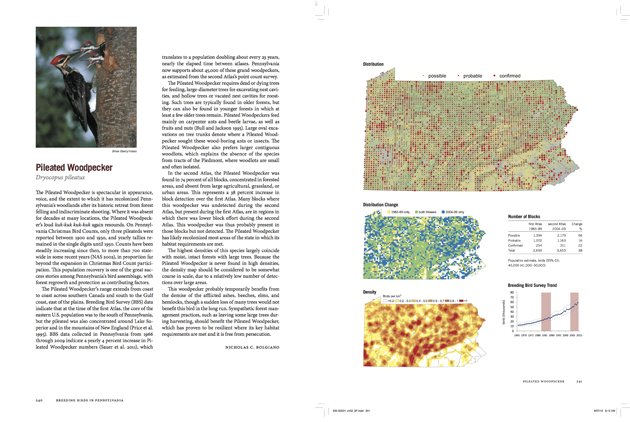
Looking at this combination of textual and graphic data, I learned a lot about each bird in a few minutes. Pileated Woodpecker, for example. My heart is happy, because I can see that the bird’s breeding presence in Pennsylvania has dramatically increased. The Distribution Map shows a lot of red, particularly the big red circles that mean confirmed breeding. The distribution map of the state is filled with green (counted for both atlases) and blue (second atlas period only) but very little yellow (first atlas period only), meaning there are many more blocks where breeding activity was observed. The chart of breeding bird survey data goes up, up, up, particularly for the period from 1990 to 2010. The block table states there is a 38 percent increase in possible, probable, and confirmed breeding. The text expands on all this; Pileated Woodpecker is, in fact, “one of the great success stories among Pennsylvania’s bird assemblage”; growing in number from Christmas Bird Counts of less than ten birds a year to the second atlas count a presence in 74 percent of all blocks, probably an undercount, according to the author. Let’s hear it for the return of the forest!
In addition to Pileated Woodpecker, the Second Atlas of Breeding Birds in Pennsylvania documents increases in numbers of Yellow-bellied Sapsucker, Hooded Warbler, Red-bellied Woodpecker, Carolina Wren, Alder Flycatcher, Common Raven, Wild Turkey, and, of course, Canada Goose. The most common bird in the state is the Song Sparrow, followed by Chipping Sparrow and Red-eyed Vireo, with American Robin coming in fourth. Sadly, there are the expected decreases for Northern Bobwhite and Ring-necked Pheasant, and for birds requiring a grassland or early successional shrubland habitat—Eastern Meadowlark, Grasshopper Sparrow, Field Sparrow, and Yellow-breasted Chat.
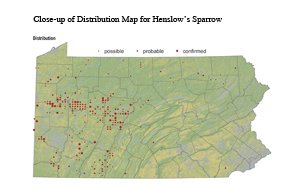 I was particularly sad to see the decline of Henslow’s Sparrow, a bird I saw for the first time in the reclaimed surface mine grasslands of western Pennsylvania. It turns out that the reclaimed mines work well as habitat for the sparrow because they collect a layer of leaf litter, a key nesting requirement. And, Pennsylvania’s Henslow’s Sparrow population, as small as it is at an estimated 7,000 males, is a significant part of an estimated world population of 80,000 individual birds. This is where the conservation goal of the breeding bird atlas plays an important role.
I was particularly sad to see the decline of Henslow’s Sparrow, a bird I saw for the first time in the reclaimed surface mine grasslands of western Pennsylvania. It turns out that the reclaimed mines work well as habitat for the sparrow because they collect a layer of leaf litter, a key nesting requirement. And, Pennsylvania’s Henslow’s Sparrow population, as small as it is at an estimated 7,000 males, is a significant part of an estimated world population of 80,000 individual birds. This is where the conservation goal of the breeding bird atlas plays an important role.
Before reading the Species Accounts, Chapter Nine of the Atlas, it might pay to take a glance at Chapter Eight, by Daniel W. Brauning and Andrew M. Wilson, two of the atlas’s editors. Interpreting Species Accounts outlines the common elements of the accounts, cites the classification system used (American Ornithologists’ Union), spells out acronyms and abbreviations, lists a gazetteer of major locations, including corresponding DeLorme map numbers, and, most importantly, explains how to read the distribution and density maps.
Which brings us back to the first seven chapter of the atlas, the ones that I skipped over to talk about the birds, but which are integral parts of the atlas as a scientific and educational volume. Aims and Purposes, by Robert S. Mulvihill, the third editor, discusses in detail how the second atlas sought to improve on the processes of the first, in quality and quantity of data as well as increased citizen participation. The Geography of Pennsylvania, by Andrew M. Wilson, and Bernd J. Haupt, gives background on the physical geography of the state, from the Appalachian Plateaus to the Central Lowlands to the narrow Atlantic Coastal Plain, and its climate. Habitats and Habitat Change, by Wilson, Joseph Bishop, and Margaret Brittingham expands on the importance of knowing about habitat in order to understand changes in avian breeding practices. Changes in Pennsylvania’s forests, farmlands, wetlands, and grasslands are traced from the time of the first European settlers, when forest predominated, to the present period, with 11 percent of the state developed, some wetland loss, some wetland gain, and the danger of pollution in riparian habitats. The most interesting habitat story in my opinion, as I mentioned above, is the reclamation of the land formerly used for coal mining, mostly in the western part of the state, with an estimated 86,000 acres now grassland.
Atlas Methods, by Brauning and Michael Lanzone, and Analytical Methods, by Wilson describe the methods used to count and map the state’s birds and analyze the data. This content is technical at times, but worth reading for insight into the challenges of conducting a breeding bird survey as well as the material itself. For example, how does an observer actually determine if a bird is breeding in a specific area? Well, there is the chance of actually seeing breeding in process, but evidence of a not so specific nature is usually required, and the survey designers developed codes for a variety of breeding behaviors, including ritualized courtship displays, territorial behavior, adults seen carry nesting material, nest containing eggs, adult seen carrying fecal sac, and adult seen feeding fledglings. This material is not new to breeding bird surveys or experienced birders, but I found the codes and the highly specific details of the code descriptions quite interesting. Similarly, the description of how the Point Count sampling project worked, conjured up images of trained observers walking through woods and grasslands utilizing a mix of high and low technology, counting singing males within time bands determined by stopwatches, documenting location with GPS units, and categorizing habitat data with pencil and paper.
The seven Appendices are a mix of scientific charts, tables, and supplementary materials, including a list and discussion of Former Nesting Species by Daniel W. Brauning, a Summary of Atlas Results by Physiographic Region and Section, Breeding Phenology (date ranges of nest building, nest with eggs, nest with young, fledged young), Atlas Safe Dates (the period of time within which it is safe to say that if you saw or heard a bird in suitable habitat it is likely breeding, ruling out migrants). The appendix section on Habitat Associations, in which graphs delineate the main habitat type and the relationship between abundance and elevation for selected species, looks particularly interesting. The Literature Cited section is exceptional, a lengthy, up-to-date, bibliographically flawless listing of scholarly articles, chapters from other breeding bird atlases, technical manuals, and ornithological chapters from The Birds of North America Online. Similarly, the Index details page locations for birds by common and scientific name, with species account pages in boldface. Topics such as habitat type and threats to bird survival are listed as general topics and with specific birds. So, if you want to read about West Nile Virus, you have your choice of reading about the disease as it affects the American Crow, American Kestrel, and down the list to Tufted Titmouse.
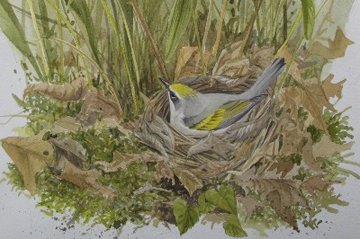 There is a tradition of combining breeding bird atlases with bird art. The Atlas of the Breeding Birds of Nevada (Univ. of Nevada Press, 2007) features a cover by David Sibley. A stunning painting of Red-faced Warblers, by artist and field ornithologist Narca Moore-Craig, shout out from the cover of the Arizona Breeding Bird Atlas (Univ. of New Mexico Press, 2005). The Second Atlas of Breeding Birds in New York State (Cornell Univ. Press, 2008) commissioned hundreds of black-and-white bird drawings to illustrate its species accounts. The first Atlas of Breeding Birds in Pennsylvania, published by University of Pittsburgh Press in 1992, wore a lovely painting of nesting Chestnut-sided Warblers by Julie Zickefoose. For the Second Atlas, a second painting by Julie was commissioned, in memory of Dr. Kenneth C. Parkes, Curator of Birds at Carnegie Museum of Natural History for more than 33 years. The painting shows a male Brewster’s Warbler bringing food to a Golden-winged Warbler on the nest. It is a finely detailed, beautiful painting, as you can see from the detail at left and the full cover in our featured photo, above. Julie’s birds breathe. But it is an odd choice considering that hybrids like the Brewster’s Warbler, a product of Blue-winged Warbler with a Golden-winged Warbler, are partially responsible for the decline of the Golden-winged Warbler. The choice makes more sense when you learn that Dr. Parkes wrote THE scientific paper on The Genetics of the Golden-winged x Blue-winged Warbler complex in 1951. Also, it is noted in the Second Atlas that this scene was actually observed not once but twice, by two different observers, during the survey process. So, you can say that Julie’s painting reflects the goals of the breeding bird survey, to report all observations, the good and the bad, and to use them to create an ecology that supports the growth of birds and bird habitat.
There is a tradition of combining breeding bird atlases with bird art. The Atlas of the Breeding Birds of Nevada (Univ. of Nevada Press, 2007) features a cover by David Sibley. A stunning painting of Red-faced Warblers, by artist and field ornithologist Narca Moore-Craig, shout out from the cover of the Arizona Breeding Bird Atlas (Univ. of New Mexico Press, 2005). The Second Atlas of Breeding Birds in New York State (Cornell Univ. Press, 2008) commissioned hundreds of black-and-white bird drawings to illustrate its species accounts. The first Atlas of Breeding Birds in Pennsylvania, published by University of Pittsburgh Press in 1992, wore a lovely painting of nesting Chestnut-sided Warblers by Julie Zickefoose. For the Second Atlas, a second painting by Julie was commissioned, in memory of Dr. Kenneth C. Parkes, Curator of Birds at Carnegie Museum of Natural History for more than 33 years. The painting shows a male Brewster’s Warbler bringing food to a Golden-winged Warbler on the nest. It is a finely detailed, beautiful painting, as you can see from the detail at left and the full cover in our featured photo, above. Julie’s birds breathe. But it is an odd choice considering that hybrids like the Brewster’s Warbler, a product of Blue-winged Warbler with a Golden-winged Warbler, are partially responsible for the decline of the Golden-winged Warbler. The choice makes more sense when you learn that Dr. Parkes wrote THE scientific paper on The Genetics of the Golden-winged x Blue-winged Warbler complex in 1951. Also, it is noted in the Second Atlas that this scene was actually observed not once but twice, by two different observers, during the survey process. So, you can say that Julie’s painting reflects the goals of the breeding bird survey, to report all observations, the good and the bad, and to use them to create an ecology that supports the growth of birds and bird habitat.
Thousands of people were involved in the Second Atlas of Breeding Birds in Pennsylvania, but only three are named as the editors of this volume: Andrew M. Wilson, Visiting Assistant Professor of
Environmental Studies at Gettysburg College, Daniel W. Brauning, Chief Nongame Ornithologist for the Pennsylvania Game Commission, and Robert S. Mulvihill, Director of Education at the National Aviary in Pittsburgh. Brauning was Project Director for the first Atlas and now again for this one. Mulvihill was Project Coordinator of the Second Atlas and also involved with the first one. I am always interested in the stories behind the making of the books I review, so I spent some time reading the newsletter, The PennsylAvian Monitor, published for volunteers during the 5-plus years of the atlas project. The newsletter, full of progress summaries, instructions, profiles of volunteers, and recruitment appeals to students, hunters, fisherman, and pretty much anyone who did anything outdoors in the state, gives a sense of the collective energy that went into the Atlas and the community that they created. It’s an energy that doubtless came from these men, and I think they deserve respect for that as much as for their scientific results.
The Second Atlas of Breeding Birds in Pennsylvania is a book that is likely to set a standard for future atlas endeavors, both in the methodology used in the multi-year atlas process and in the comprehensive subject coverage and graphic precision of the book itself. Like most breeding bird atlases, it is a well-made book, and an expensive one, even using the eBird discount described below. Also, like many current atlases, you can find its distribution data on the Internet, in this case through 2nd Breeding Bird Atlas portal, courtesy of the Cornell Laboratory of Ornithology. Distribution data is not the same as a Species Account, and I think interested birders need to weigh the convenience of the online information against the quality and price of the written word. Remember, this is a book that will be good for at least the next twenty years! It is an investment that will hopefully be considered by serious birders and ornithologically-inclined graduate students in Pennsylvania and nearby areas. It is also a title that should be requested for purchase by your local and college libraries. I am very curious to know what breeding bird atlases you have in your personal library and how you use them. And, if you are part of an ongoing atlas project in your state, tell us about your experiences. Behind every distribution map, there must be a fascinating birding experience.
Images courtesy of Pennsylvania State University Press.
Second Atlas of Breeding Birds in Pennsylvania,
edited by Andrew Wilson, Daniel Brauning, Robert Mulvihill.
Geoff Malosh, Photo Editor; Catherine D. Haffner, Production Assistance and Editing; Andrew Mack, Bibliographer.
University Park: The Pennsylvania State University Press, 2012. 616 pages.
ISBN-10: 0271056304, ISBN-13: 978-0271056302.
Dimensions: 12.3 x 9.5 x 1.9 inches; 6.4 pounds.
Price: $64.95 (For 20% discount code, see the eBird article 2nd Breeding Bird Atlas Book Published). Also, discounted prices through the usual suspects.













Excellent review, Donna, as always.
Just a slightly different take on the winged warblers and the (very pretty) cover painting:
There’s nothing ‘bad’ about the interbreeding of the winged warblers, and it’s misleading to say that the hybrids and backcrosses are “responsible” for the decline of the Golden-winged Warbler–they’re the result of that process.
The painting pays sentimental tribute to Kenneth Parkes, as it rightly should, but the scene doesn’t have to be read as admonitory. To my mind it merely depicts a significant shift in the breeding distributions, abundance, and habits of two birds on the way (back?) to becoming one. And we should probably feel just as sorry for the Blue-winged Warblers as for the golden-wings, since their “purity” is just as compromised by the interbreeding of the two. I love Golden-winged Warblers and miss seeing them more often, but these things happen, fascinatingly, and the Second Atlas does a great job of helping us watch nature as she naturates.
Thanks for sharing the valuable information with us. I am so much Interested to know more and more about birds as you gave so much information. Waiting for your next blog.
The recently concluded Ohio BBA turned me from a bird watcher into a birder. My observations of 14 turkey vulture nests were turned into two articles for state level journals.
Atlasing forces you to slow down and observe birds and perhaps most importantly, it forces you to bird areas you would not normally go. My best example of this was when the director contacted me and asked me to survey a block that had no data. The block was bordered by the Ohio River and was a third of a block. It was 40% residential and 20% industrial and bisected by a four-lane highway. I agreed to do it but was not very enthusiastic as I loaded my kayak. I could not have been more surprised at the birds I found along the river and up a small creek in that block: Broad-winged hawk feeding young, spotted sandpiper fledglings, osprey nest, bank and cliff swallows feeding all around me as my paddling stirred up the mayflies hatching that day, to name just a few. It was a great day.
I switched to the WV BBA to feed my addiction. For any PA birders needing a fix, WV had only a little over 100 people enter data last year! We need help.